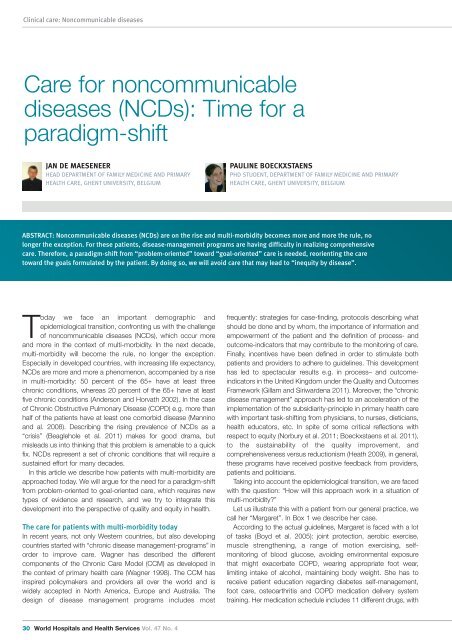web_vol47 4.pdf - International Hospital Federation
web_vol47 4.pdf - International Hospital Federation
web_vol47 4.pdf - International Hospital Federation
You also want an ePaper? Increase the reach of your titles
YUMPU automatically turns print PDFs into web optimized ePapers that Google loves.
Clinical care: Noncommunicable diseases<br />
Care for noncommunicable<br />
diseases (NCDs): Time for a<br />
paradigm-shift<br />
JAN DE MAESENEER<br />
HEAD DEPARTMENT OF FAMILY MEDICINE AND PRIMARY<br />
HEALTH CARE, GHENT UNIVERSITY, BELGIUM<br />
PAULINE BOECKXSTAENS<br />
PHD STUDENT, DEPARTMENT OF FAMILY MEDICINE AND PRIMARY<br />
HEALTH CARE, GHENT UNIVERSITY, BELGIUM<br />
ABSTRACT: Noncommunicable diseases (NCDs) are on the rise and multi-morbidity becomes more and more the rule, no<br />
longer the exception. For these patients, disease-management programs are having difficulty in realizing comprehensive<br />
care. Therefore, a paradigm-shift from “problem-oriented” toward “goal-oriented” care is needed, reorienting the care<br />
toward the goals formulated by the patient. By doing so, we will avoid care that may lead to “inequity by disease”.<br />
Today we face an important demographic and<br />
epidemiological transition, confronting us with the challenge<br />
of noncommunicable diseases (NCDs), which occur more<br />
and more in the context of multi-morbidity. In the next decade,<br />
multi-morbidity will become the rule, no longer the exception.<br />
Especially in developed countries, with increasing life expectancy,<br />
NCDs are more and more a phenomenon, accompanied by a rise<br />
in multi-morbidity: 50 percent of the 65+ have at least three<br />
chronic conditions, whereas 20 percent of the 65+ have at least<br />
five chronic conditions (Anderson and Horvath 2002). In the case<br />
of Chronic Obstructive Pulmonary Disease (COPD) e.g. more than<br />
half of the patients have at least one comorbid disease (Mannino<br />
and al. 2008). Describing the rising prevalence of NCDs as a<br />
“crisis” (Beaglehole et al. 2011) makes for good drama, but<br />
misleads us into thinking that this problem is amenable to a quick<br />
fix. NCDs represent a set of chronic conditions that will require a<br />
sustained effort for many decades.<br />
In this article we describe how patients with multi-morbidity are<br />
approached today. We will argue for the need for a paradigm-shift<br />
from problem-oriented to goal-oriented care, which requires new<br />
types of evidence and research, and we try to integrate this<br />
development into the perspective of quality and equity in health.<br />
The care for patients with multi-morbidity today<br />
In recent years, not only Western countries, but also developing<br />
countries started with “chronic disease management-programs” in<br />
order to improve care. Wagner has described the different<br />
components of the Chronic Care Model (CCM) as developed in<br />
the context of primary health care (Wagner 1998). The CCM has<br />
inspired policymakers and providers all over the world and is<br />
widely accepted in North America, Europe and Australia. The<br />
design of disease management programs includes most<br />
frequently: strategies for case-finding, protocols describing what<br />
should be done and by whom, the importance of information and<br />
empowerment of the patient and the definition of process- and<br />
outcome-indicators that may contribute to the monitoring of care.<br />
Finally, incentives have been defined in order to stimulate both<br />
patients and providers to adhere to guidelines. This development<br />
has led to spectacular results e.g. in process– and outcomeindicators<br />
in the United Kingdom under the Quality and Outcomes<br />
Framework (Gillam and Siriwardena 2011). Moreover, the “chronic<br />
disease management” approach has led to an acceleration of the<br />
implementation of the subsidiarity-principle in primary health care<br />
with important task-shifting from physicians, to nurses, dieticians,<br />
health educators, etc. In spite of some critical reflections with<br />
respect to equity (Norbury et al. 2011; Boeckxstaens et al. 2011),<br />
to the sustainability of the quality improvement, and<br />
comprehensiveness versus reductionism (Heath 2009), in general,<br />
these programs have received positive feedback from providers,<br />
patients and politicians.<br />
Taking into account the epidemiological transition, we are faced<br />
with the question: “How will this approach work in a situation of<br />
multi-morbidity?”<br />
Let us illustrate this with a patient from our general practice, we<br />
call her “Margaret”. In Box 1 we describe her case.<br />
According to the actual guidelines, Margaret is faced with a lot<br />
of tasks (Boyd et al. 2005): joint protection, aerobic exercise,<br />
muscle strengthening, a range of motion exercising, selfmonitoring<br />
of blood glucose, avoiding environmental exposure<br />
that might exacerbate COPD, wearing appropriate foot wear,<br />
limiting intake of alcohol, maintaining body weight. She has to<br />
receive patient education regarding diabetes self-management,<br />
foot care, osteoarthritis and COPD medication delivery system<br />
training. Her medication schedule includes 11 different drugs, with<br />
30 World <strong>Hospital</strong>s and Health Services Vol. 47 No. 4
















